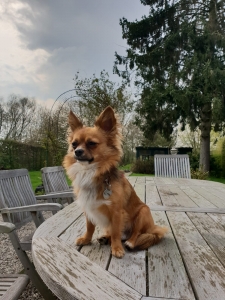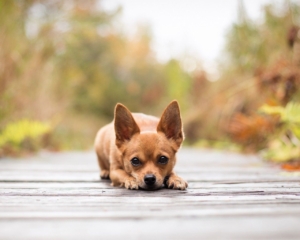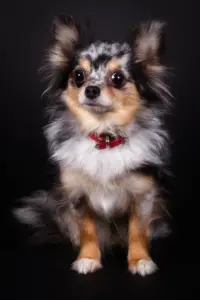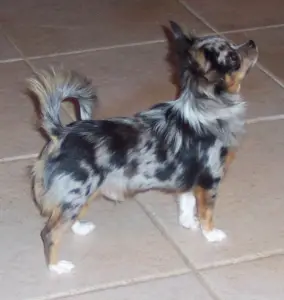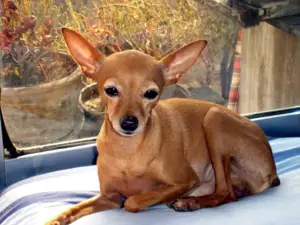Chihuahua Weight & height
The Chihuahua is the smallest breed of dog in the world. And as an owner it is important to be aware if your Chihuahua is overweight or underweight. Seen as it is such a small dog, even the tiniest weight change can make a huge difference in his/her appearance. The advised maximum weight by the AKC (US) and the Kennel Club UK is 2.7kg. The FCI and the CKC (Canada) on the other hand keep the maximum at 3kg. Most kennel clubs do not have an advised minimum weight but your Chihuahua should weight at least 0.5kg. Since height can range from 6-9 inches (15 – 23 cm) it is impossible to give one ideal weight for each Chi. Please note that is perfectly normal for your Chihuahua to fall outside of the advised weight range (0.5-3kg) if he/she also falls outside the advised height range.
Chihuahua life expectancy
As for most breeds the average lifespan depends on a number of factors.
- A good diet has a strong correlation with the lifespan of any dog. Try to look for well-balanced premium dog food that has a minimum of fillers and/or preservatives.
- Chihuahuas require vaccinations and follow-up shots to protect against disease like the parvovirus and canine influenza.
- Getting your Chi sprayed or neutered has the benefit that they tend to live longer due to a reduced risk of testicular or ovarian cancer.
- Like other small breeds, Chihuahuas are susceptible to dental problems like tooth decay. Bacteria that live in and around the mouth can enter the bloodstream through bleeding gums.
- Doing daily exercise with your Chi active is crucial to a long and healthy life. Exercise burns excess fat and strengthens their immune system.
The Chihuahua is (one of) the longest living of any other breed of dog. So if you keep in mind the 5 pointers above you can expect your Chihuahua to reach 14 to 15 years. It is even possible for them to go above 20 years. Every year for us can be seen as 4,5 to 5 dog years for them.
Chihuahua coat color
A unique characteristic of Chihuahuas is that they come in virtually any possible color combination. This is the case for both the short haired and long haired type.
- Tri-colored is any combination of three colors although the major color is often brown or black. The white is mostly situated on the underside of the body, such as on the chest and the feet.
- Merle is a variation on the tri-color with the difference that the pattern is not uniform. The colors are divided in a pattern of marbled spots in the coat. Merle Chi’s often have a unique eye color such as blue.
- Piebald also known as Pied, indicates that the Chi is completely white with exception of its head, tail base and small parts of its back.
- Brindle also known as ‘tiger striped’ is a pattern of stripes that tend to be darker than the base of the coat.
- Sable pattern is more common in long-haired coat Chihuahuas but it can also exist for short-haired ones. Chihuahuas with a sable pattern have a darker top coat compared to their bottom.
Chihuahua Intelligence
Chihuahuas have the biggest brain of any dog breed relative to their size. They’re easy to train however they are very difficult to housebreak due to the fact that they have a tiny bladder and a strong personality.
However, anyone who has a Chihuahua knows they are quite intelligent and have strong characters. Dog intelligence is measured by their ability to understand a situation and its adaptive intelligence. Most of these skills are learnt at a very young age from its mother or owner. Some forms of intelligence are related to instincts and come naturally. Dog often learn from other dogs and animals, so having a good social understanding is the first step to a smart dog.
Remaining things the dog must learn from its owner. Working and obedience intelligence is measured by how many repetitions it takes for your dog to react to a command.

CHIHUAHUA Hype & POPULARITY
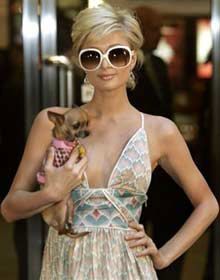
The popularity of Chihuahuas peaked for the first time in 2002 when it was the 9th most popular dog breed worldwide. This was mostly due to a Chihuahua named Gidget who featured in the insanely well known Taco Bell commercials. Throughout the 2000s the Chihuahua remained very popular.
By 2007, when Paris Hilton and Teacup were hot news, the Chihuahua’s popularity had dropped to the 13th place. The last official figures that were collected date back to 2013 when the FCI collected registration figures from 25 different countries. After the Labrador, German Shepherd and the Poodle the Chihuahua came in 4th with 107.114 registrations!
Aggression
A study found that Chihuahuas are one of the most aggressive breeds towards humans and other dogs. In order to prevent this it is important to socialize your Chi from an early age.
We distinguish 5 forms of aggressive behaviour
- Fear-related aggression
- Most dogs bite when they are scared and is most common for dogs that did not socialise at young age
- In case of fear-related aggression, tell guests to avoid eye contact and let them drop some treats on the floor. This will give a positive signal to your dog that strangers do not always mean danger.
- Hunting-related aggression
- Every dog has some form of hunting instinct, which is why it is important to simulate hunting with squeaking toys.
- In case of hunting-related aggression seek professional help.
- Gender-related aggressionFemale dogs tend to bite quicker when they feel protective over their young. Male dogs tend to become more aggressive when they are confronted with a similar sized and same sex dog.
- Sterilisation reduces gender-related aggression.
- Possession-related aggression
- Some dogs can become aggressive over their food or a favourite toy.
- In case of possession-related aggression it is best to permanently takeaway toys over which the dog becomes aggressive. It is important to pet your dog at a young age while it is eating, you can accommodate this by adding a few treats into his/her bowl.
- Dominance-related aggression
- Most dogs tend to increase their position within their family, it is possible that they show aggressive tendencies towards (the smaller) family members.
- Do not treat this aggression with aggression as it will reinforce the behaviour. It is important to use a firm voice or even isolate your dog when confronted with this behaviour.
